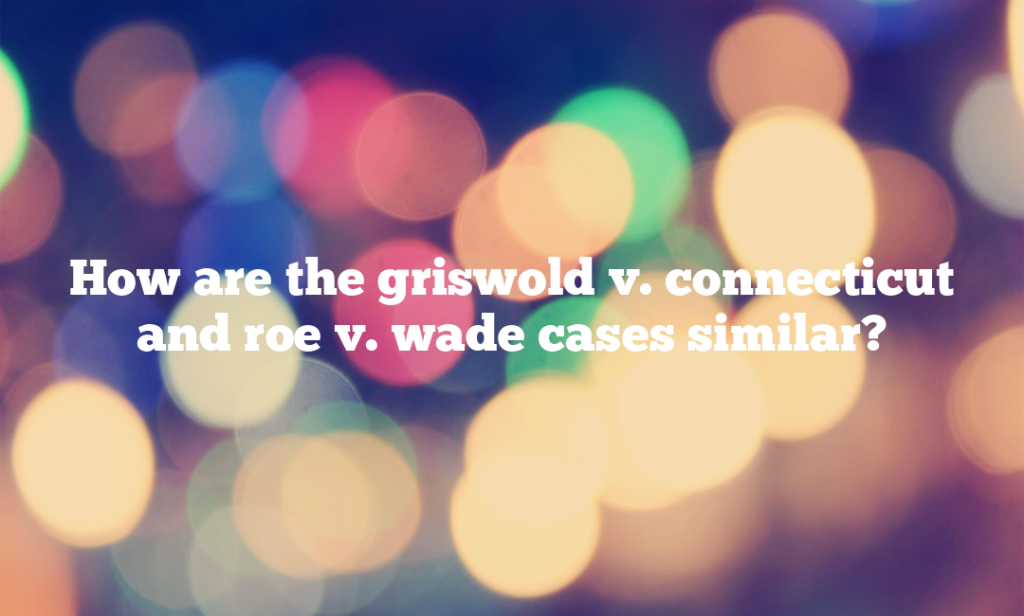How are the griswold v. connecticut and roe v. wade cases similar?
In the realm of constitutional law, Griswold v. Connecticut and Roe v. Wade stand as pillars, reshaping the legal landscape concerning individual rights and privacy. This comparative analysis delves into the progression from the recognition of a constitutional right to privacy in Griswold to the broader assertion of individual choice in Roe, exploring the nuanced evolution of these landmark cases and their enduring impact on constitutional jurisprudence.
Table of Contents
Toggle
Griswold v. Connecticut: Pioneering the Right to Privacy
The Marital Privacy Paradigm
Griswold v. Connecticut, decided in 1965, marked a turning point in the jurisprudence surrounding privacy. At its core, the case challenged a Connecticut law criminalizing the use of contraceptives, even by married couples. Writing for the majority, Justice William O. Douglas articulated a right to privacy, grounded in the Bill of Rights’ penumbras and emanations, specifically protecting marital relationships from unwarranted state intrusion.
The Foundations of Privacy as a Constitutional Right
Griswold laid the foundations for recognizing privacy as a constitutional right. The Court’s rationale extended beyond the explicit language of the Constitution, asserting that certain rights are implied and fundamental to the overall protection of individual liberties. This conceptual leap set the stage for a more expansive understanding of privacy in subsequent cases, including Roe v. Wade.
Roe v. Wade: Expanding the Realm of Individual Choice
Extending Privacy to Reproductive Choices
Roe v. Wade, decided in 1973, built upon the foundation laid by Griswold but expanded the concept of privacy to include reproductive choices. The case challenged a Texas statute criminalizing most abortions except to save the life of the mother. Justice Harry Blackmun, writing for the majority, declared that a woman’s right to choose to have an abortion fell within the protected sphere of privacy established in Griswold.
The Right to Choose: A Paradigm Shift
Roe represented a paradigm shift from privacy to the recognition of an individual’s right to make decisions about their own body. The Court acknowledged that the decision to have an abortion is deeply personal, falling within the zone of privacy and autonomy protected by the Constitution. This marked a departure from Griswold’s focus on marital privacy, expanding the scope to individual reproductive decisions.
Comparative Analysis: Unraveling the Threads of Privacy and Choice
Evolution of the Concept of Privacy
A comparative analysis reveals the evolution of the concept of privacy from Griswold to Roe. Griswold established the groundwork by recognizing privacy as a constitutional right within the context of marriage. Roe, by extending this right to encompass reproductive choices, demonstrated a nuanced understanding of privacy as a dynamic and evolving concept that adapts to the changing contours of societal norms.
From Marital Privacy to Individual Autonomy
Griswold’s emphasis on marital privacy reflects the societal attitudes of its time, where notions of privacy were intertwined with the sanctity of marriage. Roe, however, reflects a broader understanding of individual autonomy, acknowledging that personal decisions related to reproductive choices extend beyond the confines of marital relationships. The evolution is not just in legal doctrine but mirrors a societal shift towards recognizing individual agency.
Legal Framework: Due Process and Fundamental Rights
Due Process as the Common Denominator
The legal framework connecting Griswold and Roe centers on the Due Process Clause of the Fourteenth Amendment. Griswold argued that Connecticut’s prohibition on contraceptives violated the right to marital privacy protected by the Due Process Clause. Roe extended this reasoning to reproductive choices, asserting that a state law restricting access to abortion interfered with a woman’s fundamental right to privacy and personal autonomy.
Fundamental Rights Doctrine
Both cases drew upon the fundamental rights doctrine, asserting that certain liberties are so essential to individual freedom that they are protected against state infringement. Griswold laid the groundwork by identifying the right to privacy as a fundamental right, and Roe expanded this doctrine to include a woman’s fundamental right to make decisions about her reproductive health. This doctrinal extension forms a key element of the comparative analysis.
Intersection of Privacy and Choice: Navigating Legal and Ethical Dimensions
Common Ethical Underpinnings
The intersection of privacy and choice in Griswold and Roe reveals common ethical underpinnings. Both cases grapple with the question of how far the state can intrude into personal decisions that touch upon deeply intimate aspects of individuals’ lives. The ethical dimension of respecting personal autonomy and the right to make decisions about one’s own body is a unifying theme, bridging the gap between these two landmark cases.
Legal Challenges and Ethical Dilemmas
While Griswold and Roe assert constitutional protections, they also faced legal challenges and ethical dilemmas. Griswold confronted traditional values that questioned the existence of a constitutional right to privacy, and Roe ignited a protracted debate on the moral and legal dimensions of abortion. Both cases exemplify the tension between individual rights and societal values, highlighting the complex interplay of law, ethics, and public opinion.
Judicial Activism and Social Impact: A Comparative Lens
Judicial Activism in Griswold
Griswold and Roe share a common theme of judicial activism, where the Court took proactive steps to interpret the Constitution in light of evolving societal norms. Griswold challenged entrenched beliefs about privacy within marriage, asserting a constitutional right not explicitly stated in the text. This judicial activism set the stage for Roe, where the Court continued its bold approach by extending constitutional protections to reproductive choices.
Social Impact and Backlash
Both cases triggered social impact and backlash, reflecting the broader societal conversations surrounding privacy and reproductive rights. Griswold faced opposition rooted in traditional values that questioned the legitimacy of judicially implied rights, and Roe sparked a divisive discourse on the morality and legality of abortion. The social impact of these cases reverberates through ongoing debates and movements that continue to shape legal and political landscapes.
Conclusion: Legacy and Ongoing Evolution
Legacy of Griswold and Roe
In concluding this comparative analysis, the legacy of Griswold and Roe is profound. Griswold laid the groundwork for recognizing privacy as a constitutional right, and Roe expanded this concept to encompass individual choices about reproductive health. Together, they form a constitutional tapestry, weaving together threads of privacy, autonomy, and individual agency.
Ongoing Evolution and Challenges
The journey from privacy to choice, as witnessed in the comparative analysis of Griswold and Roe, reflects an ongoing evolution in constitutional jurisprudence. Challenges persist, both legally and ethically, as society grapples with questions of individual rights and the limits of state authority. Griswold and Roe remain integral chapters in an ongoing narrative, inspiring continued discourse on the ever-evolving nature of constitutional interpretation and the delicate balance between privacy and individual choice.




